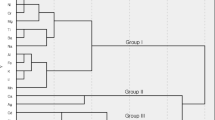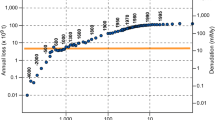Abstract
As outlined in Chap. 3, the geochemistry of environmental media is largely dependent on the chemistry of the natural sources from which they have been derived, or with which they have interacted. Thus soil and surficial sediment chemistry are strongly influenced by the composition of their parent materials. Similarly stream and river waters, derived initially from precipitation, depend on the rocks, sediments, and soils from which they come into contact and interact with for their chemical composition. However, with the evolution of humans in the relatively recent geological past there have been anthropogenic impacts on the environment, which have increased dramatically with increasing population, urbanization, and industrialization (Fyfe 1998). Thus humans have contaminated or polluted the once pristine environment, and this impact is manifested in the chemistry of environmental materials that reflect anthropogenic signals superimposed on the natural composition.
Access this chapter
Tax calculation will be finalised at checkout
Purchases are for personal use only
Similar content being viewed by others
References
Al-Atia MJ (1972) Trace elements in Iraqi oils and their geological significance. In: Mineral exploitation and economic geology. University of Wales, Aberystwyth
Alloway BJ (ed) (1995) Heavy metals in soils, 2nd edn. Blackie Academic & Professional, London
British Geological Survey (1992) Regional geochemistry of the Lake District and adjacent areas. British Geological Survey, Keyworth
Brothwood S (2001) Vehicle related emissions of platinum group elements and other heavy metals in the urban environment, PhD thesis, University of Wales, Aberystwyth
Burns KN, Allcroft R (1964) Fluorosis in cattle: occurrence and effects in industrial areas of England and Wales 1954–57, industrial disease surveys, reports 2, part 1. Ministry of Agriculture Fisheries and Food, London
Coleman L, Bragg LJ, Finkelman RB (1993) Distribution and mode of occurrence of selenium in US coals. Environ Geochem Health 15:215–227
Dabkowska E, Machoy-Mokrzynska A, Straszko J, Machoy Z, Samujlo D (1995) Temporal changes in the fluoride levels of jaws of European deer in industrial regions of Western Pomerania, Poland. Environ Geochem Health 17:155–158
Davies BE, Houghton NJ (1984) Distance-decline patterns in heavy metal contamination of soils and plants in Birmingham, England. Urban Ecol 8:285–294
Davis RD (1980) The uptake of fluoride by ryegrass grown on soil treated with sewage sludge. Environ Pollut B 1:277–284
Davis A, Kempton JH, Nicholson A, Yare B (1994) Groundwater transport of arsenic and chromium at a historical tannery, Woburn, Massachusetts, USA. Appl Geochem 9:569–582
Ding Z, Zheng B, Long J, Belkin HE, Finkelman RB, Chen C, Zhou D, Zhou Y (2001) Geological and geochemical characteristics of high arsenic coals from endemic arsenosis areas in Southwestern Guizhou province, China. Appl Geochem 16:1353–1360
Farmer JG, Eades LJ, Graham MC (1999) The lead content and isotopiccomposition of British coals and their implications for past and present releases of lead to the UK environment. Environ Geochem Health 21:257–272
Frank A (1998) “Mysterious” moose disease in Sweden. Similarities to copper deficiency and/or molybdenosis in cattle and sheep. Biochemical background of clinical signs and organ lesions. Sci Total Environ 209:17–26
Frank A, Madej A, Galgan V, Petersson LR (1996) Vanadium poisoning of cattle with basic slag. Concentrations in tissues from poisoned animals and from a reference, slaughter house material. Sci Total Environ 181:73–92
Fuge R, Hennah TJ (1989) Fluorine and heavy metals in the vicinity of brickworks. Trace Subst Environ Health 23:183–197
Fuge R, Perkins WT (1991) Aluminum and heavy metals in potable waters of the North Ceredigion area, Mid-Wales. Environ Geochem Health 13:56–65
Fyfe WS (1998) Towards 2050; the past is not the Key to the future; challenges for science and chemistry. Environ Geol Health 33:92–95
Gummow B, Botha CJ, Basson AT, Bastianello SS (1991) Copper toxicity in ruminants: air pollution as a possible cause. Onderstepoort J Vet Res 58:33–39
Gummow B, Bastianello SS, Botha CJ, Smith HJC, Basson AT, Wells B (1994) Vanadium air pollution: a cause of malabsorption and immunosuppression in cattle. Onderstepoort J Vet Res 61:303–316
Hodge VF, Stallard MO (1986) Platinum and palladium in roadside dust. Environ Sci Technol 20:1058–1060
Kharaka YK, Ambats G, Presser TS, Davis RA (1996) Removal of selenium from contaminated agricultural drainage water by nanofiltration membranes. Appl Geochem 11:797–802
Kimball BE, Rimstidt JD, Brantley SL (2010) Chalcopyrite dissolution rate laws. Appl Geochem 25:972–983
Koritnig S (1972) Fluorine. In: Wedepohl KH (ed) Handbook of geochemistry. Springer, Berlin, chap. 9
Leece DR, Scheltema JH, Anttonen T, Weir RG (1986) Fluoride accumulation and toxicity in grapevines Vitus vinifera L. in New South Wales. Environ Pollut A 40:145–172
Levinson AA (1980) Introduction to exploration geochemistry, 2nd edn. Applied Publishing, Wilmette
Mielke HW (1994) Lead in New Orleans soils: New images of an urban environment. Environ Geochem Health 16:123–128
Mirvish SS (1991) The significance for human health of nitrate, nitrite and N-nitroso compounds. In: Bogárdi I, Kuzelka RD, Ennenga WG (eds) Nitrate contamination exposure, consequences and control. Springer, New York, pp 253–266
Nicholson FA, Smith SR, Alloway BJ, Carlton-Smith C, Chambers B (2003) An inventory of heavy metals inputs to agricultural soils in England and Wales. Sci Total Environ 311:205–219
Pacyna JM (1995) The origin of Arctic air pollutants: lessons learned and future research. Sci Total Environ 160/161:39–53
Perkins WT (2011) Extreme selenium and tellurium contamination of soils – an eighty year-old industrial legacy surrounding a Nickel refinery in the Swansea Valley. Sci Total Environ 412/413:162–169
Reimann C, Äyräs M, Chekushin VA, Bogatyrev IV, Boyd R, de Caritat P, Dutter R, Finne TE, Halleraker JH, Jæger Ø, Kashulina G, Lehto O, Niskavaara H, Pavlov VA, Räisänen ML, Strand T, Volden T (1998) Environmental geochemical atlas of the central Barents region. Geological Survey of Norway, Trondheim
Rice KC, Herman JS (2012) Acidification of earth: an assessment across mechanisms and scales. Appl Geochem 27:1–14
Rieuwerts JS, Farago ME (1996) Heavy metal pollution in the vicinity of a secondary lead smelter in the Czech republic. Appl Geochem 11:17–23
Rühling Å (ed) (1994) Atmospheric heavy metal deposition in Europe—estimations based on moss analysis. Nordic Council of Ministers, Copenhagen
Stohl A, Seibert P, Wotawa G, Arnold D, Burkhart JF, Eckhardt S, Tapia C, Vargas A, Yasunari TJ (2011) Xenon-133 and caesium-137 releases into the atmosphere from the Fukushima Dai-Ichi nuclear power plant: determination of the source term, atmospheric dispersion, and deposition. Atmos Chem Phys Discuss 11:28319–28394
Zheng B, Hong Y (1988) Geochemical environment related to human endemic fluorosis in China. In: Thornton I (ed) Geochemistry and health. Science Reviews Limited, Northwood, pp 93–96
Zielinski RA, Simmons KR, Orem WH (2000) Use of 234U and 238U isotopes to identify fertilizer-derived uranium in the Florida everglades. Appl Geochem 15:369–383
Author information
Authors and Affiliations
Corresponding author
Editor information
Editors and Affiliations
Rights and permissions
Copyright information
© 2013 Springer Science+Business Media Dordrecht
About this chapter
Cite this chapter
Fuge, R. (2013). Anthropogenic Sources. In: Selinus, O. (eds) Essentials of Medical Geology. Springer, Dordrecht. https://doi.org/10.1007/978-94-007-4375-5_4
Download citation
DOI: https://doi.org/10.1007/978-94-007-4375-5_4
Published:
Publisher Name: Springer, Dordrecht
Print ISBN: 978-94-007-4374-8
Online ISBN: 978-94-007-4375-5
eBook Packages: Earth and Environmental ScienceEarth and Environmental Science (R0)




